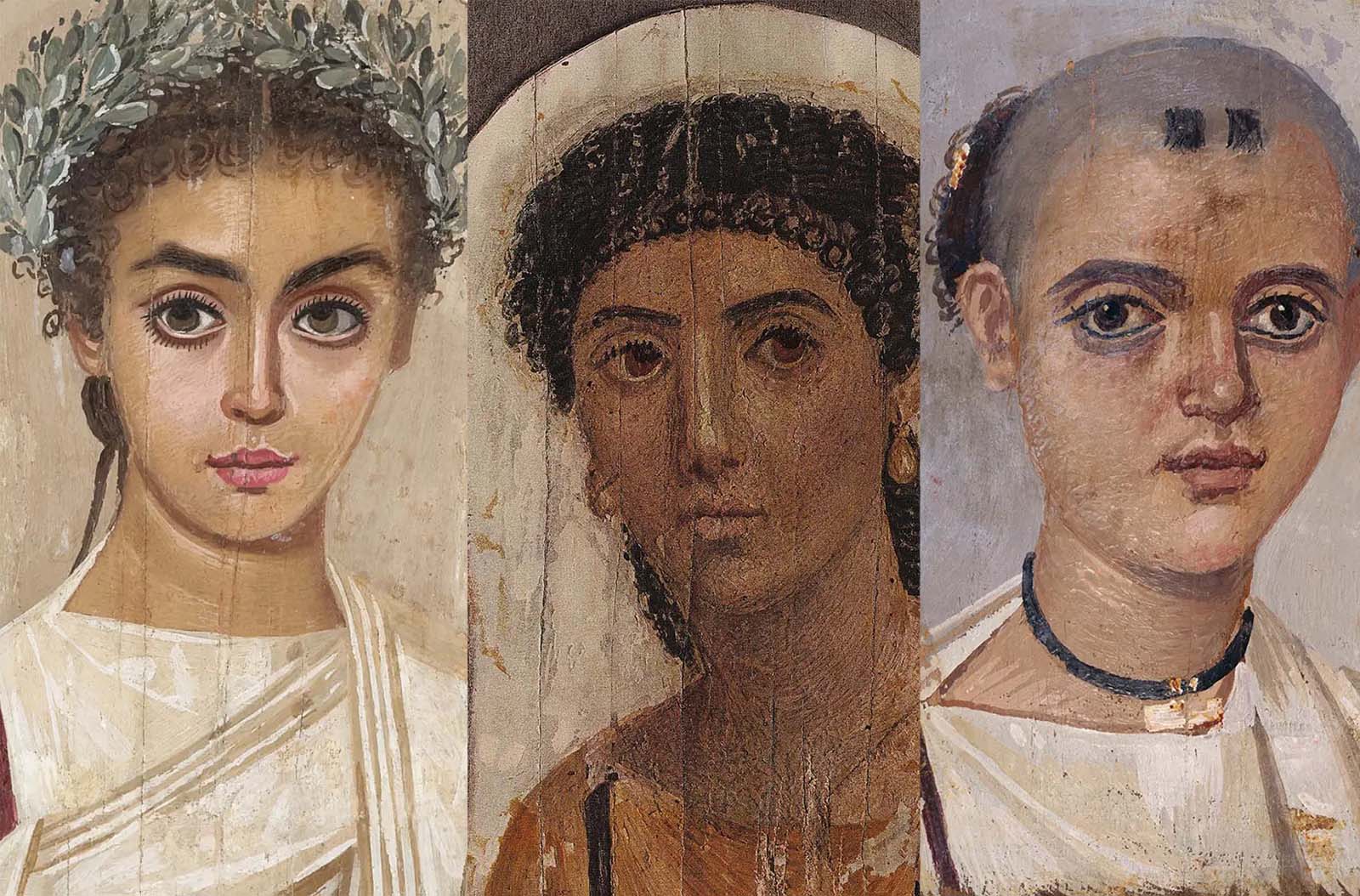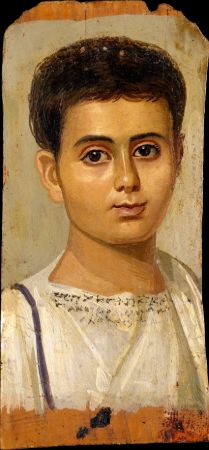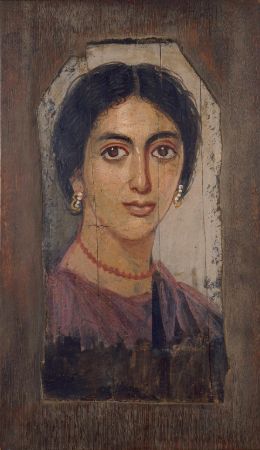What is Fayum mummy portraits?
Fayum portrait is a name given to portrait paintings on wooden boards placed on the head of mummified corpses in the 1st and 3rd centuries in Egypt.

These faces, which look directly at the viewer with their striking eyes, are the first known portraits of the world.
These works are also the first typical icon paintings known for their unique features. There are about 1000 mummy portraits that have survived to the present day. Although the portraits were excavated from mummy tombs in many parts of Egypt, they were named so because the majority were found in the Fayyum region.
Mummy portraits or Fayum mummy portraits are a type of naturalistic painted portrait on wooden boards attached to upper class mummies from Roman Egypt. They belong to the tradition of panel painting, one of the most highly regarded forms of art in the Classical world. The Fayum portraits are the only large body of art from that tradition to have survived. They were formerly, and incorrectly, called Coptic portraits.
Fayyum is located in western Egypt, about a hundred kilometers south of Cairo. The ancient Egyptians called this area Mer-Our (Great Lake). Fayyum was ruled by the pharaohs in BC. Although the population was quite low between 3000-300 BC, it is one of the settlement areas where the earliest food production experiments were made in Egypt.

Fayyum's fate, which played an important role throughout the dynasty, changed with the change of Egyptian administration, turning into a multicultural structure. The mercenaries of Alexander the Great, who occupied Egypt, preferred to settle in many regions in Egypt, especially the Fayyum region, instead of returning to their homes. Therefore, the Greeks who settled in Fayyum the earliest are the wounded and high-ranking soldiers who left after the war. The soldiers, who were given land from these regions, took charge of the local government units in their own regions after a while and became the administrators of these regions.
Since the culture, art, and education level of the Greeks are quite advanced, they also made themselves accepted in other social areas. Gradually, Greek culture began to spread in many parts of Egypt, and even their official language was accepted as Greek. The Greeks, who settled in Fayyum, built hundreds of buildings and made important contributions to the architecture of this region. These structures include complex temples, pyramids, palaces, and hunting lodges.

BC when the Romans seized power. After 31 years, Roman laws dominated the whole country. Although the ancient Greek elite of rulers and landowners lost some of their privileges, they retained their position in society as citizens of the upper and middle classes compared to the native Egyptian people. It is known that the descendants of the Greeks preserved their way of life and cultural heritage during the three centuries that the Romans dominated Egypt. However, the religious beliefs of the Greeks did not show the same continuity, instead, they adopted the belief system of Egypt. Since the Egyptians believed that the soul lived after death and that the soul sought its own body, they gave importance to mummy-making. While the Greeks were burying their dead, they were influenced by Egyptian traditions and began to embalm their dead. The Romans, who came to power later, practiced this tradition for their own dead. But unlike their predecessors, they had two-dimensional mummy portraits of the deceased instead of the masks placed on the faces of the mummies.
After the mummified body was wrapped in bandages, the portrait of the corpse was attached to the face of the corpse with bandages. The mummy, which was placed upright in a coffin resembling a human body, sealed and written on its identity, was later placed in the burial chamber.
Mummy portraits are works produced in the classical art understanding of the Greeks so that the souls can easily find their own appearance. Fayyum portraits bear the characteristics of a period in which the Greek cultural heritage, the Roman domination that left its mark on the political and social order, and the Egyptians' belief in another life after death coexisted.

In 1615, Italian explorer Pietro della Valle was the first European to visit Egypt and discover these mummies. Although their interest in Ancient Egypt continued to increase, Europeans were not aware of these portraits until the 19th century. In 1820 the Baron of Minotuli collected several mummy portraits for a German collector. However, the cargo ship, including these portraits, was lost in the North Sea along with other Egyptian artworks. In 1827, Léon de Laborde returned to Florence with 2 portraits from Egypt, and in 1828-29 the French orientalist explorer Jean-François Champollion returned to Florence with much more mummy paintings. Throughout the 1820s, the British consul general in Egypt sent a large number of portraits to Paris and London. Today, mummy portraits are exhibited in all major archaeological museums in different parts of the world. Louvre Museum in Paris, British Museum, Royal Scottish Museum, New York Metropolitan Museum are some of the important art centers where Fayum portraits are exhibited.
It is known that some of the painters who made Fayum portraits were Greeks who settled and worked in cities such as Alexandria after the Greek kings came under the rule of Egypt after Alexander the Great conquered Egypt. Painters were seen as craftsmen rather than artists, just as in ancient Greece. Based on the information given by the Roman writer and philosopher Plinius on Roman painting in Chapter 35 of his Natural History, we can say that the first examples of portrait art date to the Ancient Roman period. In the section in question, Plinius mentions that a female painter named Iaia (Iaia of Kyzikos), one of the painters who lived during the reign of Emperor Augustus, was a portrait painter. Stating that Iaia mostly made portraits of women, apart from self-portraits, Plinius also states that this painter was quite productive and his works found buyers at high prices. According to the historian Sir Ernst Hans Josef Gombrich, these portraits, which still impress the audience with their lively and realistic looks, came from the hands of unpretentious masters who were employed cheaply. However, the natural appearance in the portraits indicates that the painter has a good command of anatomy, and the three-dimensional view he has captured indicates that he has a good knowledge of light and shadow.
The majority of Fayyum portraits are painted on panels or plates of imported hardwoods such as oak, lemon, sycamore, cypress, cedar, fig, and citrus. After the trees were cut into thin panels with a thickness of about 1.5 cm, they were sanded and smoothed. The finished panels were placed between the bandages surrounding the body, in such a way that the face of the mummy could be seen directly when it was opened. The wooden surfaces were primed and ready to be painted before starting the painting. Usually, the figures are depicted as a bust on a background painted in monochrome (painting in different shades of one color).
The color tones in the portraits made with the tempera technique have smooth transitions since they are obtained with fine brush strokes, and have a matte appearance due to the use of colors with white added to them. Most of the pigments are derived from natural substances such as tree roots and indigo. In some portraits, leaf gold was also used to depict jewelry and head wreaths.

The real magic in Fayyum portraits is in the eyes. Since the eyes are made larger than the face, it adds strength to the expression and leaves an impressive impression by drawing the viewer in. These pictures are not made for viewers. This is the most important element that makes them fascinating. The fact that he will go on a journey to the other world with the person on his death journey has caused the person to experience the most intense emotions together while making the portrait. It is obvious that the painter also wanted to highlight the expression by sharing similar feelings for the reason he made the portrait.
--------------------------------------------------
The stunning lifelike Fayum mummy portraits of Roman Egypt, 100 BC-200 AD
https://rarehistoricalphotos.com/fayum-portraits-roman-egypt-photos/
The Oldest Modernist Paintings
Two thousand years before Picasso, artists in Egypt painted some of the most arresting portraits in the history of art
https://www.smithsonianmag.com/history/the-oldest-modernist-paintings-20169750/
